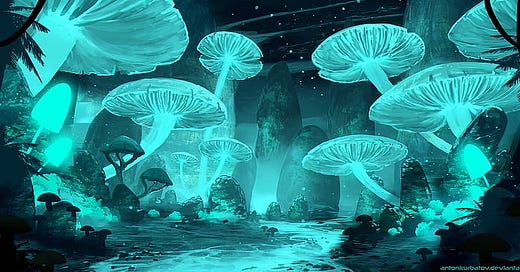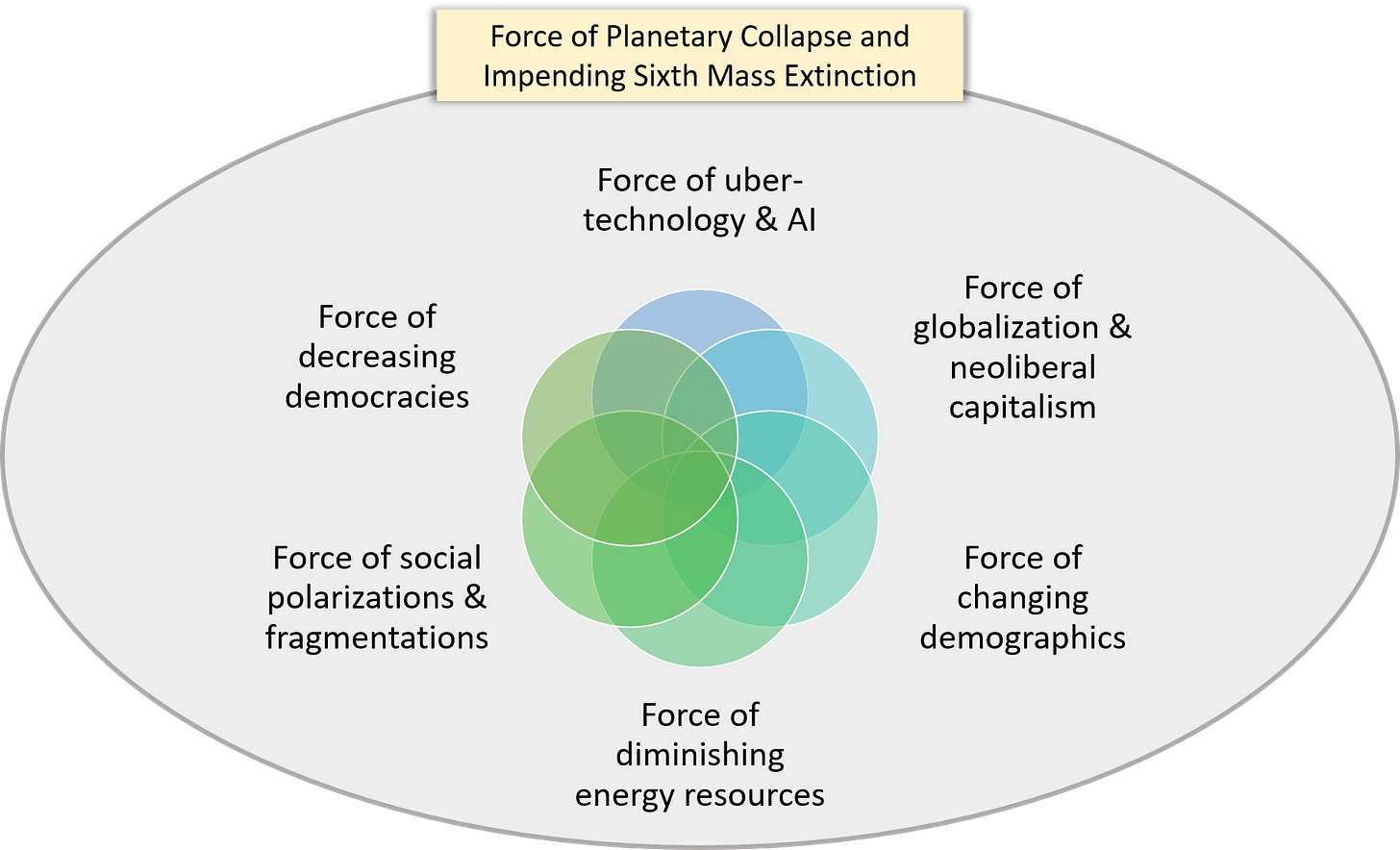A Tentative Manifesto for the Future of Organizations — 4
Embracing fearless imagination and visionary existentialism
When the waves come crashing over seawalls and washes away cities and its millions, when forest fires consume and advance, when artic ice melts to nothing, will organizations be proud to have captured the largest market share?
When there are no resources to draw from, when civil wars threaten, and money can’t buy food, will organizations gloat about beating their competition?
When millions of climate refugees flee and children go hungry, how will organizations directly responsible for the climate crises respond?
The reality is these are not fragments of a dystopian future. They are already happening. NOW. Grief shrouds remote Pakistan mountain village after Greece migrant boat tragedy. “An air of melancholy engulfs the small village of Bandali in Pakistan-administered Kashmir, where hopes are fading fast for nearly two dozen residents who went abroad in search of a better life and have since disappeared.”
There is a time for hope and there is a time for realism. But what is needed now is beyond hope and realism. This is a time when we ought to dedicate ourselves to bringing about the greatest shift in human consciousness and in the way we live. ~Artists must confront the climate crisis — we must write as if these are the last days, Ben Okri
So a new existentialism is called for. Not the existentialism of Camus and Jean-Paul Sartre, negative and stoical in spirit, but a brave and visionary existentialism, where as artists we dedicate our lives to nothing short of re-dreaming society. We have to be strong dreamers. We have to ask unthinkable questions. We have to go right to the roots of what makes us such a devouring species, overly competitive, conquest-driven, hierarchical. ~Ben Okri
This is why I propose existential creativity, to serve the unavoidable truth of our times, and a visionary existentialism, to serve the future that we must bring about from the brink of our environmental catastrophe.
Mushrooms called “banger chhata” in Bengali, which literally translates to “frogs’ umbrellas,” were a source of endless fascination for me.
As a kid, I used to be fascinated by the profusion of mushrooms that’d just pop up from nooks and crannies of the crumbling, moss-covered terrace walls of our ancient house in Kolkata after a few days of heavy showers during the monsoon. I was strictly told not to touch them. But that didn’t stop me from intently peering into them — lying on my stomach for better viewing — and waiting for a frog to appear. Frogs did appear. But I never saw one sitting under a mushroom. But the mushrooms continued to amaze.
This random childhood memory was triggered by a re-reading of The Mushroom at the End of the World: On the Possibility of Life in a Capitalist Ruins by Anna Lowenhaupt Tsing. And I recalled my feelings of awe and joy at life’s ability to erupt from and claim the most unpromising of places (I didn’t have the words then but just a sense of intense joy).
What if precarity, indeterminacy, and what we imagine as trivial are the center of the systematicity we seek? ~The Mushroom at the End of the World: On the Possibility of Life in a Capitalist Ruin
Maybe we need to sharpen our senses and heighten our sensibilities. We are entering an autumnal phase in our civilization. It’s time to pause, retreat, and sense with all our beings.
My articles are not answers. I don’t venture to have any. They are mostly open-ended assemblages of observations, explorations, questions, and tentative offerings. I have, here and there, included some practices, methods, and frameworks to anchor my sensemaking and synthesizing process. I have liberally quoted many (always citing sources), learned from multitudes of worldviews and ontologies (still learning), and tried to consolidate my insights.
This series is as much an offering as an effort to build coherence in my own understanding. It’s also an attempt to move beyond the merely cognitive to an integrated and emergent learning space.
Fearless Imagination
The exercise of imagination is dangerous to those who profit from the way things are because it has the power to show that the way things are is not permanent, not universal, not necessary. ~Ursula Le Guin: The Wave in the Mind: Talks and Essays on the Writer, the Reader and the Imagination
Wayfinders are organizations that dare to break free of the grip of the toxic triumvirate of power, profit, and privilege, and to build infrastructures for imagination. With stakes as high as the collapse of our planetary ecosystems, it is time for organizations to reimagine very different, paradigm-shifting narratives. Being able to make a difference to the world is a powerfully enlivening force, and an Evolutionary Purpose that will draw the best of minds and hearts to collaborate and co-create.
I reiterate: I believe organizations have the power to shift the civilizational narrative(s) and co-create regenerative, life-sustaining societies in harmony with our planetary wellbeing.
To become Wayfinders, organizations need to build capacities that are counter-intuitive, and often deemed counter-productive in the current GDP-driven era. Delinking wellbeing from the modernist/colonialist notions of progress, growth, and development opens up the space for an entirely different viewing of possibilities — those existing in the nooks and crannies of a world on the verge of ruin. Life continues to erupt from the most unlikely places. Just like mushrooms.
It requires imagination, curiosity, and a noticing of the world around us. I invite organizations to move into this space of noticing and imagining, sensemaking and synthesizing, meaning-making and learning. It is time to look for what has been ignored because they never fit the mainstream narrative. In these ignored and hidden patches of the world, the seeds of the future can be found.
World-making projects emerge from practical activities of making lives; in the process these projects alter our planet. … Making worlds is not limited to humans. …world-making projects can overlap, making room for more than one species. ~The Mushroom at the End of the World: On the Possibility of Life in a Capitalist Ruins
For organizations to become Wayfinders, there will need to be a period of hospicing of what no longer works. This doesn’t mean a surrendering of the vision; instead it positions organizations to reimagine themselves more deeply into and through them, and find their more meaningful and life-affirming expressions. This will mean letting go of the single vision of profit, of the false notions of success and competition, of the underlying patriarchal psychology of power and control.
Unless organizations can truly mature into becoming Wayfinders, they will continue to be swayed by the endless pendulum swings of profit and loss, market forces, and investor tantrums. Organizations have to heal themselves, re-discover their raison d’être, slow down long enough to explore their sources of obsession with profit at the cost of life. When organizations truly come of age, they can transition into Wayfinders — containers for life-sustaining and regenerative civilizational narratives of the future. Crucibles and safe spaces for the fullest expressions of human potentials.
From the compost of the old, the new, emergent ways can effectively arise.
A constant reshaping of life and living are happening — whether we like it or not. Wayfinders can become partners in this reshaping by becoming containers for fearless imagining. Fearless Imagination asks, What else is possible? What can we collectively imagine that an individual never can? Wayfinders have to engage in “multi-species world-making projects.” What I mean by that is “Wayfinders have to consciously move from an Anthropocentric worldview to a Biocentric worldview.” I’ll explain this in a bit. First, a short detour.
The Risks of BAU
Organizations can continue the BAU way for maybe another decade. I don’t really know but even World Bank (the capitalist stronghold) is predicting a grim future.
Today nearly all the economic forces that drove economic progress are in retreat. In the decade before COVID-19, a global slowdown in productivity — which is essential for income growth and higher wages — was already adding to concerns about long-term economic prospects. In this decade, total factor productivity is expected to grow at its slowest clip since 2000.
The result could be a lost decade in the making — not just for some countries or regions as has occurred in the past — but for the whole world. Without a big and broad policy push to rejuvenate it, the global average potential GDP growth rate — the theoretical growth rate an economy can sustain over the medium term based on investment and productivity rates without risking excess inflation — is expected to fall to a three-decade low…
This broad-based slowdown in the growth rate of potential GDP has profound implications for the world’s ability to tackle the growing array of challenges unique to our times.
I am no economist but even a layman can read between the lines and understand that the investments and infrastructure crucial for these times are not going to be coming. This, then begs the question: “What use are organizations in these times when they can neither provide meaningful work nor build a livable environment?”
When the whole world is literally burning, wouldn’t it be more worthwhile for organizations to step off the treadmill, slow down, and embrace fearless imagination to reweave our civilizational narratives? Organizations are uniquely placed to create massive impact toward building “a more beautiful world.” Because they are platforms of convergence where individuals come together, the Narratives, Metaphors, and Purposes that drive organizations can exert tremendous influence on how people connect, collaborate, and co-create.
Organizations are operating against a backdrop of these interwoven and interlinked forces against an overarching threat of planetary collapse. They no longer hold the promise of meaningful work and purpose they once did. Their raison d’être have degenerated under the force of the economic monomyth. Technology, instead of becoming a force for good, have regressed into surveillance capitalism and a glorification of meaningless speed and productivity.
It is time, perhaps, to accept that along with the Holocene Epoch, the era of the Anthropocene is also over. We are in the liminal space between a profound Phase Transition on a planetary scale. And this is beckoning us towards a world that re-connects with our oneness with all of life. We are entering the Biocene.
If the Anthropocene means the Age of Humans, the Biocene means the Age of Biocenosis.
A term describing the integral connections of different organisms forming an ecological community, biocenosis embodies a fundamentally different way of viewing the way human and other-than-human life interact. Rather than having a single species atop a fictional pyramid, the biocenosis model integrates humans into a circular system of give and take, where ecological boundaries are respected and a linear economic model is recognized as an irresponsible and delusional fallacy. ~Biocene Foundation, What is the Biocene?
The Biocene is about coming home, grounding down in Earth, where we still have time to meet the ecological crisis with compassion, courage, creativity — with nothing less than our full being. ~What is the Biocene?
Will organizations continue on the road they’ve paved, even if it means annihilation of the world, causing immeasurable harm to all sentient beings?
Or will they pivot; not only in how they act but in the very way they envision themselves as the world teeters on the edge?
This will not be the work of a single organization. But those daring to become visionaries will be laying the foundations for a “world that works for all.”
This is the most critical juncture in human history — all 300,000 years of it. The choices we make now will shape everything — the planet, life on it, what kind of civilization we can have — for a very, very long time to come. So how do things look? ~Does Our Civilization Have a Future? by Umair Haque







